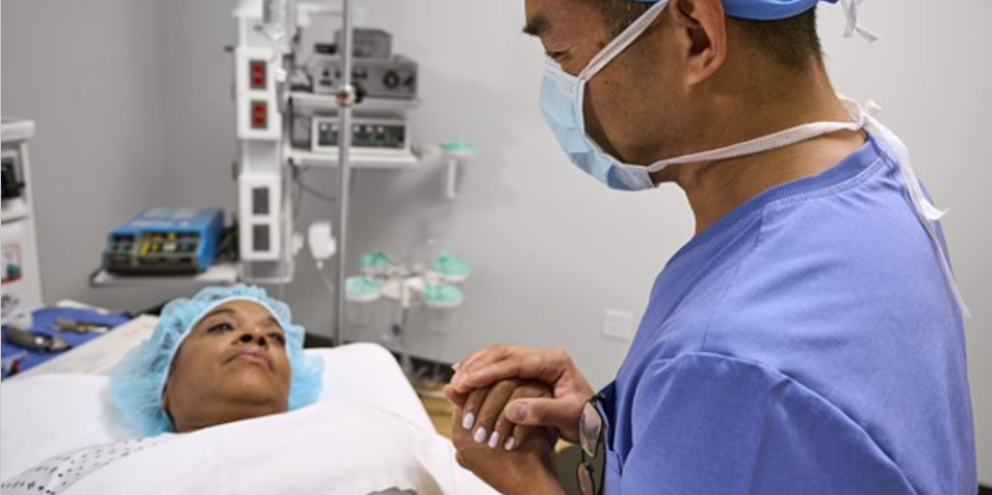
Neuromuscular blocking agents (NMBA) are often used during surgical procedures to facilitate intubation and patients must be monitored frequently to ensure optimal outcomes. However, a 2019 study funded by the European Society of Anaesthesiology and Intensive Care (ESAIC) found that clinicians don't apply neuromuscular monitoring for more than half of patients who receive NMBAs.1
"Somewhere in the history of anesthesia, we went from very careful monitoring for research studies using a stress gauge to just basically putting a finger on the patient's thumb and feeling twitches," says Dr. Stuart Grant, director of clinical research in the Department of Anesthesiology at the University of North Carolina at Chapel Hill. "What we've realized through the years is that [practicing in that way] was wrong."
In response to their own independent findings, the ESAIC, as well as the American Society of Anesthesiologists (ASA), published separate guidelines that both arrived at similar conclusions, calling for widespread adoption of quantitative monitoring of NMBAs.2
The risks of improper neuromuscular transmission (NMT) monitoring
The ESAIC-funded study found that the use of neuromuscular blocking drugs was associated with an increased risk of pulmonary complications post-procedure, and the reversal of neuromuscular blocking drugs could not decrease the risk. The study reported that 17,150 patients had received an NMBA, but over half of these patients (more than 10,000) were not monitored using NMT.
NMBAs are classified as high-alert medications with a significant risk of causing harm to patients if used incorrectly. Because NMBAs paralyze the muscles required for breathing, improper use of these drugs can lead to pulmonary problems, such as bronchitis or pneumonia. Failure to properly reverse NMBAs can also result in upper airway obstruction, reintubation, and lung collapse, which, in turn, can lead to extended hospital stays.
New guidelines for neuromuscular blockade
In light of the risks of NMBAs, the ASA and ESAIC have called for widespread adoption of guidelines developed by both organizations independently. The guidelines recommend frequent quantitative monitoring using devices to measure the depth of muscle relaxation during the intubation process.
The ASA and ESAIC recommend restructuring the clinical environment to include quantitative monitors in all anesthetizing locations. Other recommendations include:
- Promoting education efforts among individual physicians and the anesthesia department
- Providing performance feedback for individual physicians and the anesthesia department
- Appointing a champion who the organization's leaders support
The guidelines specifically recommend using ulnar nerve stimulation with quantitative monitoring at the thumb. Clinicians often measure the level of a neuromuscular block by stimulating a peripheral nerve, typically in the hand. Different nerves have varying responses to muscle relaxants, and stimulating the ulnar nerve at the wrist causes the adductor pollicis to contract and the thumb to move. Stimulating the ulnar nerve can help clinicians repeatably confirm recovery before extubation. Anesthesiologists define recovery as a train-of-four (TOF) ratio greater than or equal to 0.9.
The ASA and ESAIC guidelines also recommend:
- Using sugammadex instead of neostigmine for deep or moderate neuromuscular blockade induced by rocuronium
- Using neostigmine as a reasonable alternative to sugammadex for minimal neuromuscular blockade induced by rocuronium
- Considering neostigmine for a depth of block deeper than minimal, with the understanding that deeper blocks will require more time to attain a TOF ratio greater than or equal to 0.9 (this guideline depends on clinical judgment in the context of quantitative monitoring)
The use of sugammadex or neostigmine applies to patients who have not reached a TOF ratio of at least 0.9, according to the guidelines. Patients who recover on their own to a TOF ratio greater than or equal to 0.9 do not need NMBA reversal medication.
"One of the biggest misreadings of the guidelines is that if you give sugammadex, you don't need to worry," says Dr. Grant. "If you carefully read them, you'll see that sugammadex alone is not the answer. Sugammadex and monitoring is, and monitoring is the important part."
To encourage the implementation of the new guidelines, the ESAIC emphasized three clinically relevant core issues:
- Significance of NMBAs for tracheal intubation
- Contribution of NMBAs to improve surgical conditions
- Significance of neuromuscular monitoring and pharmacological reversal to reduce residual paralysis and post-operative pulmonary complications
Along with the ASA and ESAIC guidelines, the Anesthesia Patient Safety Foundation (APSF) also maintains that quantitative neuromuscular monitoring is the only reliable method to ensure patients adequately recover from NMBAs. It is also the only reliable means to avoid residual weakness after surgical procedures.3
Implementing the new guidelines
The ASA's guidelines acknowledge that opportunities to accelerate the adoption of quantitative monitoring must be identified.
Educating clinicians on the prevalence and consequences of residual block is critical. Institutions can help with the adoption of quantitative monitoring through identifying a departmental champion responsible for educating and training clinician colleagues to drive implementation. Previous studies have shown positive associations between exposure to champions and increased use of technological innovations.4
Key clinical references to the advantages of objective monitoring provided by healthcare institutions and champions can help. It is also essential to provide feedback along the way. These efforts should go hand-in-hand with placing quantitative monitoring equipment at all anesthetizing locations, as the presence of the monitors alone will not increase adoption or reduce post-operative residual block.
"Support people when they're using the monitor," Dr. Grant says. "It slowly changes habits. People start to use it, and they get used to using it routinely." As clinicians get used to using the monitors, they'll also discover new uses for them—not just for reversal, but how they dose the medications during surgery.
"We use laminated cards with the information available at every anesthesia machine, including how to use the monitor and directions for what reversal to give and when," Dr. Grant adds. "We found this really helped with consistency and improving patient outcomes when they went into recovery."
Barriers still remain
Despite recommendations for neuromuscular monitoring when administering NMBAs, research has found that monitoring practices are inconsistent. In a study of five Danish and one U.S. hospital, barriers to consistent and proper monitoring included:5
- Unreliable equipment
- Lack of training
- Time pressure
- Lack of standards and guidelines
- Departmental education
- Misconceptions about the pharmacokinetics of NMBAs and residual block
Additionally, the Danish hospitals used objective or quantitative monitoring, but the anesthetists had challenges calibrating the monitor and interpreting the measurements. The U.S. anesthetists used subjective monitoring, as objective monitoring was often unavailable.
Specialty societies have attempted to provide guidance for neuromuscular block management in the past. In 2017, an international panel of experts published a consensus statement proposing that clinicians should use quantitative monitoring whenever non-depolarizing NMBAs are administered to patients.6 Non-depolarizing NMBAs, such as rocuronium or atracurium, prevent acetylcholine from triggering muscle contraction. However, residual paralysis post-op is a known issue with non-depolarizing NMBAs. The statement also recommended replacing subjective monitoring and clinical evaluation of muscle strength with objective monitoring. The panel acknowledged that publishing the statement would not lead to widespread acceptance or adherence to the recommendations.
A 2022 editorial corroborates some of these barriers, particularly emphasizing the impact of a departmental education program.7
"You're trying to tell providers that these monitors are better, quicker, safer, and some people really don't appreciate that it's a problem not to monitor patients," Dr. Grant says. "However, most providers should be able to pick up after one training session how to use these monitors in the most basic fashion."
Although standards for NMT can reduce residual block, switching to quantitative monitoring requires a significant time investment. Anesthesia departments also need a champion to provide ongoing support throughout the transition. This champion must have the authority to implement the changes effectively. Additionally, anesthesia departments require structured teaching programs to educate clinicians about the consequences of residual block.
Even if anesthesia departments want to adopt the new guidelines, the lack of neuromuscular monitoring equipment remains an issue. Cost can also be a significant barrier, as many perceive NMBAs like sugammadex as cheaper than neuromuscular monitors. While neuromuscular monitors would not replace sugammadex, they can help clinicians personalize the dosage.
"If people don't monitor full recovery, you can give sugammadex and still not get a full recovery," says Dr. Grant. "And if you monitor beforehand, you can appropriately dose the sugammadex and sometimes get away with administering a lower dose."
It's important to note that postoperative complications may lead to greater costs for some healthcare organizations. According to the ASA, reducing postoperative complications and the associated costs by 66% would save the organization $4.6 million per year.8 This number includes the cost of implementing quantitative monitoring.
Many anesthetists rely heavily on sugammadex and may believe they do not need neuromuscular monitors to tell them if a patient has recovered. However, the absence of quantifiable data means the clinician cannot be entirely sure the patient is not still paralyzed when they exit the operating room. And once the patient has left the OR, it becomes difficult to connect any issues they may experience to anesthesia. The patient or their caregiver may not recognize residual weakness, which can only be detected through a subjective assessment using a peripheral nerve stimulator.
Ensuring optimal patient and provider outcomes
For anesthesia departments looking to implement the new guidelines and transition to quantitative monitoring, neuromuscular blockade monitors provide real-time insights that enable clinicians to personalize the administration of neuromuscular blocking and reversal agents.
In addition to allowing clinicians to tailor dosages more effectively, it is critical to remember that quantitative monitoring helps ensure optimal recovery for the patient. NMT monitoring technology provides quantifiable readings in real-time, allows clinicians to feel confident in their steps, and reduces the risks of residual paralysis for patients.
"Whether by EMG or ENG, any monitoring is better than none," Dr. Grant says.
Resources:
1. Cammu, G. Residual neuromuscular blockade and postoperative pulmonary complications: what does the recent evidence demonstrate?. Curr Anesthesiol Rep. 2020; 10:131–136. https://doi.org/10.1007/s40140-020-00388-4
2. Quantitative monitoring of neuromuscular blockade is vital for patients undergoing anesthesia. American Society of Anesthesiologists (ASA). Published June 5, 2023. https://www.asahq.org/about-asa/newsroom/news-releases/2023/06/quantitative-monitoring-of-neuromuscular-blockade-is-vital-for-patients-undergoing-anesthesia. Accessed October 16, 2023.
3. Advancements in quantitative neuromuscular monitoring. Anesthesia Patient Safety Foundation. Published October 4, 2021. https://www.apsf.org/article/advancements-in-quantitative-neuromuscular-monitoring/. Accessed October 16, 2023.
4. Santos, W.J., Graham, I.D., Lalonde, M. et al. The effectiveness of champions in implementing innovations in health care: a systematic review. Implement Sci Commun 3, 80 (2022). https://doi.org/10.1186/s43058-022-00315-0
5. Thomsen, JL, Marty AP, Wakatsuki S, et al. Barriers and aids to routine neuromuscular monitoring and consistent reversal 5 practice—a qualitative study. Acta Anaesthesiologica Scandinavica. 2020; 64(8): 1089–99. https://doi.org/10.1111/aas.13606.
6. Nemes, R., Renew, J.R. Clinical practice guideline for the management of neuromuscular blockade: what are the recommendations in the USA and other countries?. Curr Anesthesiol Rep. 2020; 10: 90–98. https://doi.org/10.1007/s40140-020-00389-3
7. Fülesdi, B and Brull SJ. Quantitative neuromuscular monitoring: "Love all, trust a few, do wrong to none". Anesthesia & Analgesia. July 2022; 135(1): 35-38. https://doi.org/10.1213/ANE.0000000000006035.
8. Glenn S. Murphy, Sorin J. Brull. Quantitative neuromuscular monitoring and postoperative outcomes: a narrative Review. Anesthesiology 2022; 136:345–361 doi: https://doi.org/10.1097/ALN.0000000000004044









